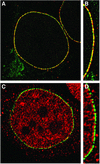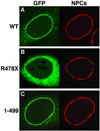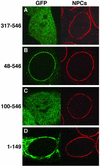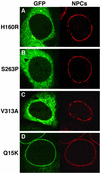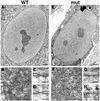The nuclear pore complex protein ALADIN is mislocalized in triple A syndrome - PubMed (original) (raw)
The nuclear pore complex protein ALADIN is mislocalized in triple A syndrome
Janet M Cronshaw et al. Proc Natl Acad Sci U S A. 2003.
Abstract
Triple A syndrome is a human autosomal recessive disorder characterized by an unusual array of tissue-specific defects. Triple A syndrome arises from mutations in a WD-repeat protein of unknown function called ALADIN (also termed Adracalin or AAAS). We showed previously that ALADIN localizes to nuclear pore complexes (NPCs), large multiprotein assemblies that are the sole sites of nucleocytoplasmic transport. Here, we present evidence indicating that NPC targeting is essential for the function of ALADIN. Characterization of mutant ALADIN proteins from triple A patients revealed a striking effect of these mutations on NPC targeting. A variety of disease-associated missense, nonsense, and frameshift mutations failed to localize to NPCs and were found predominantly in the cytoplasm. Microscopic analysis of cells from a triple A patient revealed no morphological abnormalities of the nuclei, nuclear envelopes, or NPCs. Importantly, these findings indicate that defects in NPC function, rather than structure, give rise to triple A syndrome. We propose that ALADIN plays a cell type-specific role in regulating nucleocytoplasmic transport and that this function is essential for the proper maintenance andor development of certain tissues. Our findings provide a foundation for understanding the molecular basis of triple A syndrome and may lead to unique insights into the role of nucleocytoplasmic transport in adrenal function and neurodevelopment.
Figures
Figure 1
ALADIN localizes to the cytoplasmic face of NPCs. (A and B) Colocalization of GFP-ALADIN (green) and Nup358 (red). (C and D) Colocalization of GFP-ALADIN (green) and Tpr (red).
Figure 2
The C-terminal domain of ALADIN is essential for NPC targeting. The localization of GFP-tagged ALADIN constructs is shown on the left of each image (green). (A) Wild-type ALADIN. (B) ALADINR478X. (C) ALADIN1–499. The localization of NPCs is shown on the right of each image (red) by immunostaining with mAb414 (recognizes Nup358, Nup214, Nup153, and Nup62).
Figure 3
The N-terminal domain of ALADIN is essential for NPC targeting. The localization of GFP-tagged ALADIN constructs is shown on the left of each image (green). (A) ALADIN317–546. (B) ALADIN48–546. (C) ALADIN100–546. (D) ALADIN1–149. The localization of NPCs is shown on the right of each image (red) by immunostaining with mAb414.
Figure 4
Mutations in the WD-repeat domain of ALADIN affect NPC targeting. The localization of GFP-tagged ALADIN constructs is shown on the left of each image (green). (A) ALADINH160R. (B) ALADINS263P. (C) ALADINV313A. (D) ALADINQ15K. The localization of NPCs is shown on the right of each image (red) by immunostaining with mAb414.
Figure 5
ALADIN mutant cells are morphologically normal. Shown are electron microscopy images of wild-type (A_–_D) and ALADIN mutant (E_–_H) cells showing normal nuclei (A and E) and normal NPCs in tangential section (B and F) and cross section (C, D, G, and H). (Bars: A and E, 2 μm; B and F, 500 nm; C, D, G, and H, 100 nm.)
Figure 6
ALADIN mutant cells are morphologically normal. Immunostaining of nuclear structures in wild-type (Left) and ALADIN mutant (Right) cells is shown. Cells were immunostained with mAb414 (A), anti-Nup358 (B), anti-Tpr (C), anti-lamin B (D), anti-importin-β (E), and anti-transportin (F).
Similar articles
- Cellular localization of 17 natural mutant variants of ALADIN protein in triple A syndrome - shedding light on an unexpected splice mutation.
Krumbholz M, Koehler K, Huebner A. Krumbholz M, et al. Biochem Cell Biol. 2006 Apr;84(2):243-9. doi: 10.1139/o05-198. Biochem Cell Biol. 2006. PMID: 16609705 - [From gene to disease; adrenocortical insufficiency, achalasia and disrupted tear secretion: Allgrove syndrome].
van Daele PL, de Herder WW, Huebner A. van Daele PL, et al. Ned Tijdschr Geneeskd. 2002 Nov 30;146(48):2295-7. Ned Tijdschr Geneeskd. 2002. PMID: 12497758 Review. Dutch. - The transmembrane nucleoporin NDC1 is required for targeting of ALADIN to nuclear pore complexes.
Yamazumi Y, Kamiya A, Nishida A, Nishihara A, Iemura S, Natsume T, Akiyama T. Yamazumi Y, et al. Biochem Biophys Res Commun. 2009 Nov 6;389(1):100-4. doi: 10.1016/j.bbrc.2009.08.096. Epub 2009 Aug 22. Biochem Biophys Res Commun. 2009. PMID: 19703420 - The triple A syndrome is due to mutations in ALADIN, a novel member of the nuclear pore complex.
Huebner A, Kaindl AM, Knobeloch KP, Petzold H, Mann P, Koehler K. Huebner A, et al. Endocr Res. 2004 Nov;30(4):891-9. doi: 10.1081/erc-200044138. Endocr Res. 2004. PMID: 15666842 - Triple-A Syndrome (TAS): An In-Depth Overview on Genetic and Phenotype Heterogeneity.
Pogliaghi G, Cangiano B, Duminuco P, Vezzoli V, Bonomi M. Pogliaghi G, et al. Protein Pept Lett. 2020;27(12):1192-1203. doi: 10.2174/0929866527666200613215449. Protein Pept Lett. 2020. PMID: 32533814 Review.
Cited by
- Nuclear Pore Dysfunction in Neurodegeneration.
Spead O, Zaepfel BL, Rothstein JD. Spead O, et al. Neurotherapeutics. 2022 Jul;19(4):1050-1060. doi: 10.1007/s13311-022-01293-w. Epub 2022 Sep 7. Neurotherapeutics. 2022. PMID: 36070178 Free PMC article. Review. - Intracellular ROS level is increased in fibroblasts of triple A syndrome patients.
Kind B, Koehler K, Krumbholz M, Landgraf D, Huebner A. Kind B, et al. J Mol Med (Berl). 2010 Dec;88(12):1233-42. doi: 10.1007/s00109-010-0661-y. Epub 2010 Aug 13. J Mol Med (Berl). 2010. PMID: 20706703 - The nuclear pore complex protein Tpr is a common autoantigen in sera that demonstrate nuclear envelope staining by indirect immunofluorescence.
Ou Y, Enarson P, Rattner JB, Barr SG, Fritzler MJ. Ou Y, et al. Clin Exp Immunol. 2004 May;136(2):379-87. doi: 10.1111/j.1365-2249.2004.02432.x. Clin Exp Immunol. 2004. PMID: 15086405 Free PMC article. - "Laminopathies": a wide spectrum of human diseases.
Worman HJ, Bonne G. Worman HJ, et al. Exp Cell Res. 2007 Jun 10;313(10):2121-33. doi: 10.1016/j.yexcr.2007.03.028. Epub 2007 Mar 30. Exp Cell Res. 2007. PMID: 17467691 Free PMC article. Review. - Nucleo-cytoplasmic transport defects and protein aggregates in neurodegeneration.
Bitetto G, Di Fonzo A. Bitetto G, et al. Transl Neurodegener. 2020 Jul 3;9(1):25. doi: 10.1186/s40035-020-00205-2. Transl Neurodegener. 2020. PMID: 32616075 Free PMC article. Review.
References
- Allgrove J, Clayden G S, Grant D B, Macaulay J C. Lancet. 1978;1:1284–1286. - PubMed
- Clark A J, Weber A. Endocr Rev. 1998;19:828–843. - PubMed
- Tullio-Pelet A, Salomon R, Hadj-Rabia S, Mugnier C, de Laet M H, Chaouachi B, Bakiri F, Brottier P, Cattolico L, Penet C, et al. Nat Genet. 2000;26:332–335. - PubMed
- Handschug K, Sperling S, Yoon S J, Hennig S, Clark A J, Huebner A. Hum Mol Genet. 2001;10:283–290. - PubMed
- Smith T F, Gaitatzes C, Saxena K, Neer E J. Trends Biochem Sci. 1999;24:181–185. - PubMed
Publication types
MeSH terms
Substances
LinkOut - more resources
Full Text Sources
Other Literature Sources
Medical
Molecular Biology Databases
Research Materials
